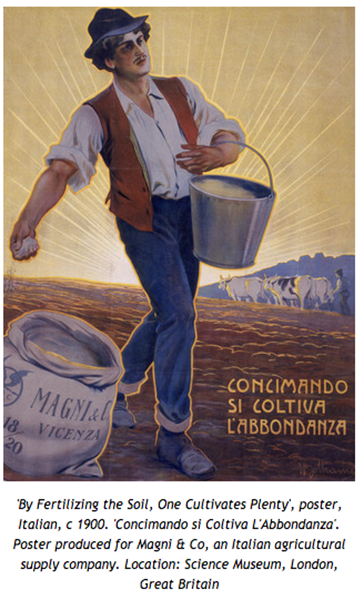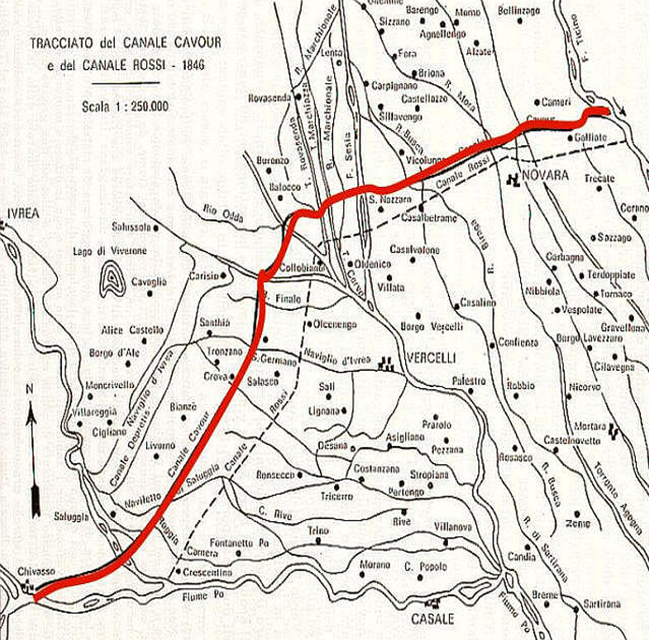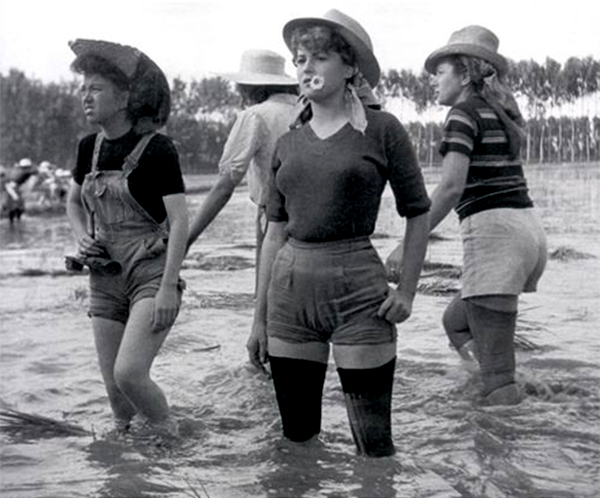Saggio da San Frediano #10 – The Fields of Piemonte – Bitter Rice – Bitter Laughter
By Peter Olney
Our friends LoLo and Viviana invited us to spend a weekend in Vercelli in early December. LoLo is “Una Vercellese” and she and Viviana make the town their home in between their epic travel adventures. Vercelli is a town of about 70,000 halfway between Milano and Torino in Piemonte. We thought Vercelli would just be a sleeping spot for day trips into Torino. Al contrario…… I couldn’t resist attending a Confederazione Generale Italiana dei Lavoratori(CGIL) rally against pension cuts on Saturday in the snow and ice of Piazza San Carlo in Torino. Christina visited the Museo Egizio whose Egyptian collection is only rivaled by the British Museum. We also visited the Lingotto production facility that housed the early production of the FIAT (1923-1982), but is now an upscale shopping mall with the Agnelli family museum on the top floor. The only sign of autos is the “Test Track” on the roof of the old factory and the FIAT logo (Fabbrica Italiana Automobilistica a Torino) stamped in concrete over the old administration building. (If you are in Southern California you can see a similar industrial plant to shopping mall conversion of the old Uniroyal Tire Plant in Commerce)
Vercelli turned out to be the highlight of our trip to Piemonte as we discovered the rice industry and the history of the female rice workers, Le Mondine (from the word “mondare” meaning to clean and husk). This rice growing region centered in the towns of Vercelli, Novara and Pavia make Italy Europe’s number one rice producer. As is often the case you have to leave your own “paese” to learn more about it. While working at the International Longshore and Warehosue Union, I on occasion assisted the workers at the giant Farmer’s Rice Mill in Sacramento, California with their negotiations and internal organizing. There were 400 of them working in the Port of Sacramento, processing rice for export on ships that would come up the Delta to be loaded and then deliver the rice to destinations in the Far East, particularly Japan where California rice was prized in the production of sushi. I knew that the rice came from north of Sacramento, cultivated in flat fields flooded with water, but I had no idea of the production process and certainly no idea about the workforce.
Education about the Italian workforce began with retired CGIL and Labor Council leader Giorgio Comella on Friday, December 1 in Vercelli. We met in the Cavour Bar in the main Piazza of the city. He explained that Vercelli was the center of a history-making struggle for the 8-hour day in 1906. He asserted that 250,000 workers, mainly women, were employed in the rice fields of the Pianura, and that many of them participated in strikes and protests that won the 8-hour standard. I asked how many workers total were employed in the fields now, and he responded about 4,000. Technology has had an impact.
This massive scale of female employment, in dramatic environmental conditions requiring young women in short shorts standing knee deep in the water, gave rise to lots of songs and movies. In fact the women were accustomed to sing as they worked and some speculate that the famous partisan anthem, “Bella Ciao” (lyrics here) came out of the rice fields. Nevertheless it is beyond speculation that the song , “Se otto ore son troppo poche”, did come out of the fields and it is a mocking declaration to the rice field owners, “If eight hours are just too little!” There are two famous movies made about the “Mondine” or “Le Risaia”. In 1949 Giussepe De Santis made “Riso Amaro” (a double entendre translated as bitter rice or bitter laugh). This movie starred Vittorio Gassman and Silvana Mangano. Then in 1956 Carlo Pontti made La Risaia starring Elsa Martinelli.
Learning about the workforce needs to be coupled with an understanding of the production process, or knowledge of working class life is limited. And of course changes in the production process have dramatically affected the workforce. On Sunday, December 3 we had the great fortune to dine at Oryzariso part of the Tenuta Castello estate that has a B&B, restaurant and production facility all in Desana north of Vercelli. We were hosted by Eduardo Vercellone whose family has farmed rice for generations. Any good day in Italy always begins with a fabulous meal, and this Sunday was no exception. Risotto was originally a “Primo piatto” eaten by peasants in the rice growing regions where the raw material was rice, not the grain which is used in the production of pasta in more southern regions. Eduardo’s restaurant has made the risotto into a gourmet delite, serving every imaginable combination of risotto with various nuts and vegetables and fruits. My favorite was Risotto with cheese, pear and walnut! Christina couldn’t resist ordering risotto mixed with brown beans. Ole!!!
After lunch we rode to Eduardo’s milling facility and he explained the whole process. Planting takes place at the end of April through the beginning of June. Irrigation has an important dual purpose. After planting, the fields are flooded for irrigation, but also because the water retains the warmth of the sunshine so that the rice plants remain warm during what can be cold nights in the plains. Then in the fall the fields are drained and the harvest is done with giant combines. He explained that the Mondine used to participate in the harvest (now mechanized) where they often encountered snakes and rats who slithered through their legs as they moved forward. And prior to the harvest Le Risaia had to manually trim off herbal infestations from the rice plant. That work has been done by herbicides now although the organic farming movement is pushing the elimination of herbicides in favor of maybe more “mondine”!
Eduardo also showed us his highly mechanized milling equipment (all made in Italia) that takes the newly harvested rice and husks it and dries it for market. While standing outside his mill I spotted the name “Singh” stenciled on the side of a giant harvester. Then an employee of the mill emerged to converse with Eduardo. He was a Sikh. Eduardo explained that there were many Sikhs involved in rice production as farmers, owners and workers. What a small world as Singh is a very common name in the Sacramento Valley and Sikh peoples have been involved in agricultural production in California since the early years of the 20th century. Eduardo promised to ask later if the worker has relatives in California, and he promised to visit our rice fields in the California delta soon.
I am inspired now to return to California and make a field trip to the 4 principal rice growing counties north of Sacramento: Colusa, Sutter, Glenn and Butte. Maybe if I had visited those fields 100 years ago I would have found strong robust women, in short pants singing “Bella Ciao’!?? Unlikely today as the California industry which is second only to Arkansas in rice production is highly mechanized like its counterpart in Italia.



Most interesting. Also some surprises. Ironically I was more aware of the rice cultivation in northern Italy than I w.as of the rice cultivation in California. (Perhaps it helped to have Silvana Mangano standing there in her shorts…) But one question I am left with: Surely neither Italy nor America produces the quantities of rice that Japan or other Asian lands do?
Peter Olney replies: Uncle John is right! 10 Largest Rice Producing Countries